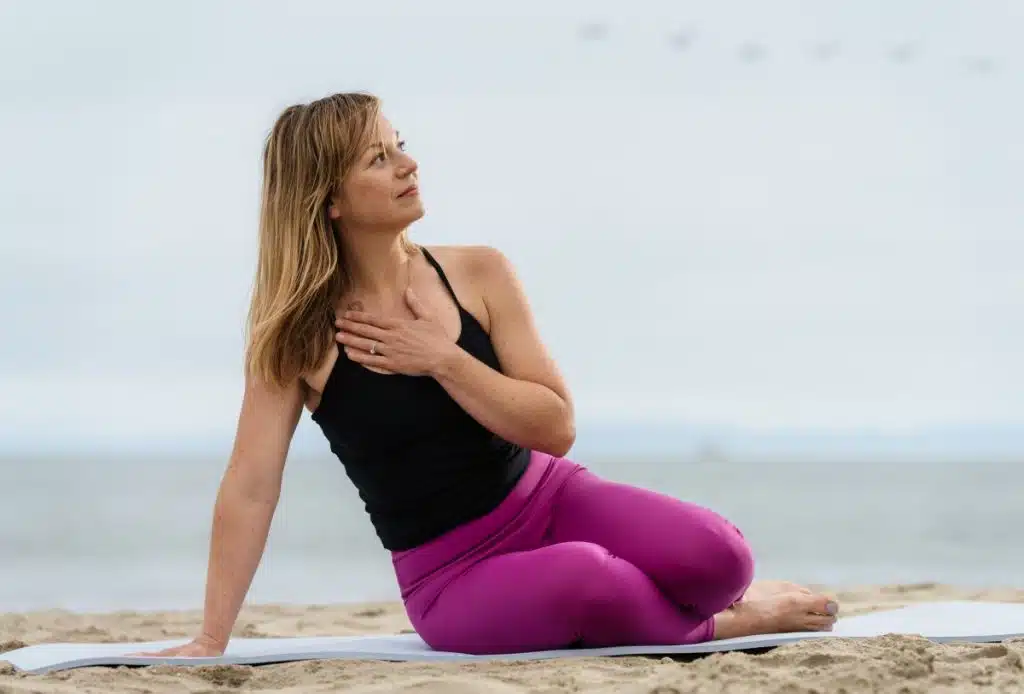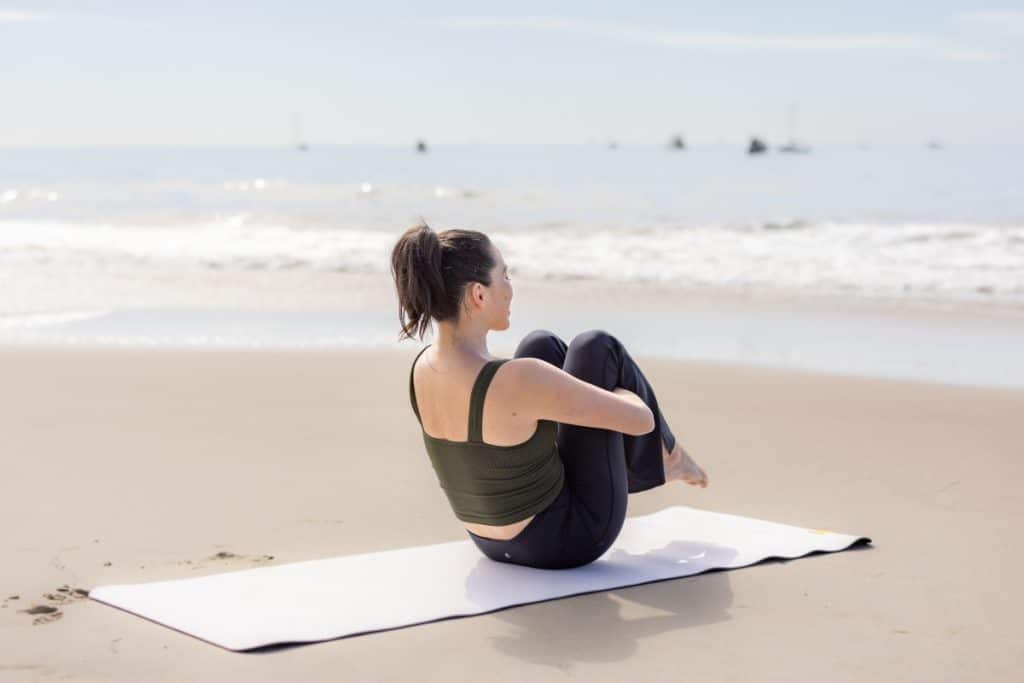
An attitude of gratitude is exactly that; it’s a way of thinking and being, rather than something you “do” here and there. This mindset may not come naturally to everyone, however (it certainly didn’t for me!), so that’s why it’s something we need to cultivate with intentional practice.
While there are many ways to cultivate an attitude of gratitude, I’m often thinking about somatic practices, which means relating to the body, distinct and separate from the mind. We spend most of the time in our heads, and for good reason—it’s from this place that we make smart and logical decisions in every area of our lives.
There are certain aspects of life, however, that can’t be solved or experienced from the mind. In fact, the body is our greatest memory keeper. While our mind forgets the details, our bodies hold onto them. Even in our tissues. When you make gratitude a whole-body practice the expression of gratitude becomes embodied into a belief held in the tissues, leading to deeper healing and support.
Instead of letting gratitude be another thing to check off your list, it can be something that comes naturally and easily—and feels really good too!

Step 1: Intentionally Identify Your Gratitude
No one walks around inherently feeling grateful all the time. Intentional gratitude, in the smallest of things, on repeat, starts to build new pathways in your brain that encourage you to find sweetness everywhere more regularly, without thinking about it.
In fact, as you practice this more, you may even start to feel the sensation of gratitude in your body before the thought even enters your mind. Suddenly you recognize it and think, wow, I’m so grateful for this moment, or whatever it may be.
The first step to cultivating this attitude of gratitude is intentionally seeking it out. For example, you might identify three things in the morning or three things at night—or both—and try that every day for seven days or a month. Make it a part of your daily routine to start building those pathways in your brain. Try it practicing gratitude every day for 30 days—you may be surprised how it changes you.
Most importantly, approach this practice with grace and release all expectations. It’s not about, I should feel this or I should feel that. The more you “should” yourself, the further you actually move away from gratitude.
Step 2: Notice Where You Feel the Gratitude
When you find that thing you’re grateful for, ask yourself: Where in my body do I feel it? Take it one step further, and ask: How does that sensation feel? It might show up in your arm. Maybe in your stomach. It could be totally unexpected and that’s perfect.
There’s no right way to do this. Your only job is to pay attention to the sensations of gratitude and the surprising ways that this feeling can show up in your body. It may be the first you’ve ever noticed this before. Even more interestingly, it may show up in a different place every time you do it, and that’s fine too.
Let yourself play with this and explore the sensations without any criticism. Whatever comes up is perfect.
Step 3: Visualize Your Gratitude
Once you identify the gratitude and feel it in your body, ask yourself: Is there a color or a texture that I can see or feel too? You might automatically sense yellow or maybe a gold shimmering light. Perhaps it feels soft. Again, there is no right or wrong—and if doesn’t come to you, that’s okay too.
Your only goal is to stay connected to the sensation. Other visualizing questions you could ask are:
- Does it have a shape?
- Is it moving?
- What does it feel like? (e.g. tingling or fluttering)
Like gratitude, naming and exploring sensations in your body is not something that comes naturally. Especially as adults, who have been taught to operate from the mind, not the body. If this feels hard, that’s okay. Remind yourself that this is a practice, not something you need to be able to do perfectly.
Step 4: Breathe Into The Gratitude
Finally, take in a slow deep breath and send it to that area of your body. This is how we can practice somatic breathwork, where we connect the breath to the body. Let your breath move the gratitude throughout your body and see how that sensation can go within your body. Can it go up into your head? Out into your arms and down into your toes?
You may want to see if your breath can radiate that gratitude outside of your body or if you can send it to people you love or even strangers you don’t even know. Let this be a fun exercise that starts within your body and pours out of you and into others as it grows and grows.
Step 5: Remember: Duality Exists
Cultivating an attitude of gratitude may feel hard sometimes. But I want you to remember that it’s totally possible (and normal) to feel gratitude alongside other difficult emotions, like grief, sadness, or anger.
In times of pain, gratitude is not going to name itself because there are other sensations that are louder and more present. During times like this, the practice becomes finding ways to be grateful for the smallest things. The funny thing is, it’s in the smallest of things that the heart starts to open up.
For example, I know right now, despite the state of the world, I’m grateful for the changing of the leaves (it’s peak fall as I write this!). I love what it looks like to see yellow and red and it makes me think about the beauty of change and the traditions of fall that I love so much. I can feel the lightness of the leaves falling in my arms, swirling down to my hands.
For today, gratitude for something as “simple” as fall is enough. My heart feels more open as I think about it. My breath naturally deepens and I feel a wave of peace wash over me. Creating this little pocket of calm and happiness on an otherwise challenging day is the goal—and you can do it in just a few minutes.
Cultivate Your Attitude of Gratitude One Day at a Time
You can’t cultivate an attitude of gratitude in one day, or one breathwork session. It’s a daily practice that you need to choose, day in and day out. The more you notice that gratitude, attune to it in your body, and breathe into it, the more naturally this comes.
On good days, this makes your happiness even brighter. On challenging days, this gives you a moment of joy or contentment that gives you the respite you need to make it through the rest of the day.
Come practice gratitude with me at Exhale Hour, a live, guided breathwork session, hosted by yours truly! You can also start your free trial of Lindywell and get instant access to 300+ Pilates workouts (like Pilates for Balance and Gratitude), dozens of guided breathwork sessions, and hundreds of nutritious recipes to fill your belly and soul with happiness.








4 thoughts on “5 Steps to Cultivate an Attitude of Gratitude With Mindfulness”
Thanks for the reminders and new tips!
We are so glad that these tips are helpful for you! We are cheering you on this holiday season and beyond!
When I sat down to read this, I was feeling holiday stress. I was feeling cynical. But as Keisha mentioned the physical feeling of gratitude and documenting our gratitude, I felt a weight lift… I realized that I’m always taking photos of the birds and flowers and deer and beautiful skies and reflections in the water, right in my own back yard. Those moments ARE me, recognizing my gratitude for the natural beauty around me.
I feel more hopeful now, just from the realization that I DO see plenty in my life and surroundings for which I’m so grateful, even when I’m stressed or irritated about other things in my life.
Exhale.
That is beautiful, Marsha! We are so glad that this resonated for you and that you found this connection. We are thankful for you!